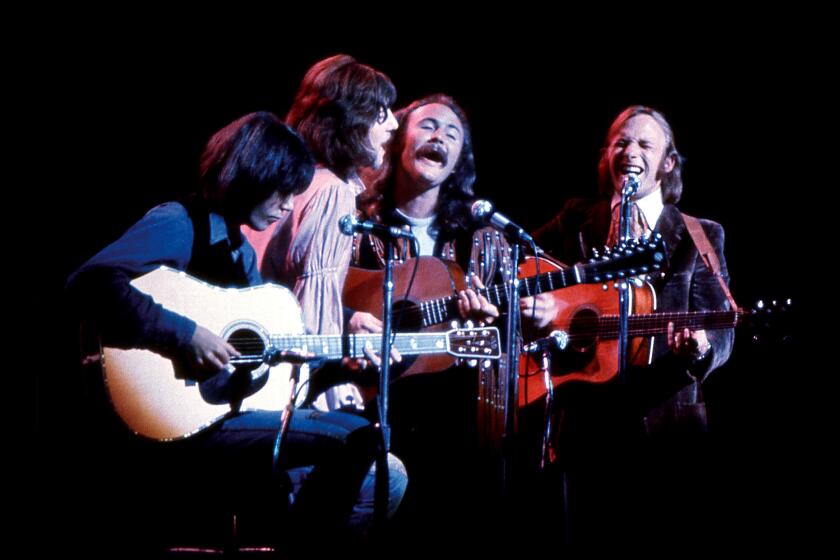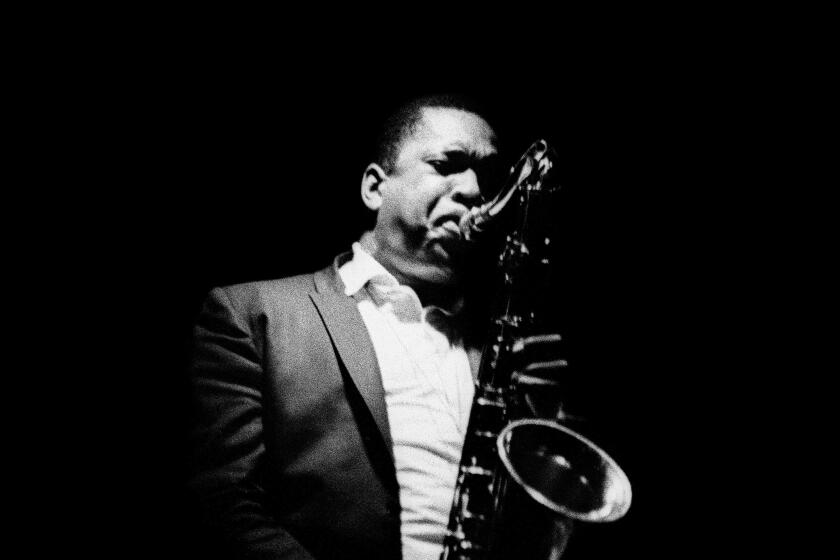The gospel according to Sister Rosetta
- Share via
Before Chuck Berry and that windmill windup, or Jerry Lee Lewis and that roiling rockabilly wail, there was Sister Rosetta Tharpe, kicking up dirt, blazing a singular, influential trail -- often in the most unlikely places.
From the pulpit to the ballpark, from the late ‘30s and well into the ‘60s, Tharpe plugged in and lighted up the most sedate or cavernous setting -- then kept stepping.
She wasn’t so interested in categories but rather the effect, the lingering emotion. She moved so quickly, effortlessly slipping between styles and genres, that she was impossible to easily categorize; her singular style (and ultimate influence) was obscured by the next fad, time and fashion.
Consequently, even though she was enormously popular in her day (her crossover smash hits include “This Train” and “Rock Me,” along with swinging reimaginings of gospel standards “Down by the Riverside” and “Didn’t It Rain”), she’s too often become a mere blur in many recollections.
But that may change.
Those who waded through Martin Scorsese’s series “The Blues” were rewarded with an electrifying glimpse of Tharpe, running it all down with her sanctified shouting and barely containable guitar work.
And there’s more Thorpe to be found: MCA last month released “The Gospel of the Blues,” an astutely representative survey of Tharpe’s back-and-forth (and back again) journey through the previously non-intersecting territories of gospel, blues and swing.
An independent label, M.C. Records, has also come to the table with a comprehensive tribute album, “Shout, Sister, Shout,” which pays homage to Tharpe’s broad range and influence. The project features a diverse grouping of artists, including Janis Ian, Odetta, Bonnie Raitt, Maria Muldaur and Victoria Williams, with a cameo by Tharpe’s cohort, gospel powerhouse Marie Knight.
A woman who persistently wiggled out of labels and conventions, Tharpe didn’t let borders and boundaries hem her in -- not musically, not socially. As an African American, she was crossing color lines. As a woman, she was going places and performing in a fashion that had previously been unheard of -- not to mention making mockery of the term “ladylike.” Tharpe, with her bright, trilling, dug-deep voice, was a sanctified gospel singer who ladled up big servings of the blues and swing and raised many an eyebrow doing so. It isn’t too often you hear it all -- the antecedents and the corollaries -- in one voice.
Flamboyant, and tailed by controversy, Tharpe, who was born in Cotton Plant, Ark., and died in 1973, influenced everyone from Berry and Lewis to B.B. King. She was a jewel but an obscured one -- something “Shout, Sister, Shout” producer Mark Carpentieri wanted to change.
“I first heard her in 1999. I was splitting a pot of coffee with [singer-guitarist] Sleepy LeBeef, who was playing DJ for a couple of hours. He would just play these little snippets, this double-slap bass. ‘Everything I’ve learned I learned from her,’ he told me,” Carpentieri says. “It was like the best thing I’d heard since I was 16!” As serendipity would have it, not too long after that, a visiting friend left behind a Tharpe compilation tape, and he fell in love again.
Inclusive project
Embedded in her voice was a people’s history: the exalted strains of the church, the hardscrabble journey of the blues. Tharpe seamlessly merged the very essence of both styles.
Without a beat of hesitation, Carpentieri was on to his next project. He called on a friend and colleague, Muldaur, and ran the idea past her. The rush in her voice at the mention of Tharpe’s name told him that it was a yes. The next task was to collect a wide range of artists to interpret Tharpe’s work. “I didn’t want it to be blues people. I wanted it to be more expansive -- that’s why you have Victoria Williams and Michelle Shocked.” They both made calls, he remembers, “but the conversation usually ended if you never heard of Sister Rosetta. You were either getting it, or you weren’t.”
Muldaur, who had seen Tharpe at a church event back in the early ‘60s, didn’t have to have it spelled out. “I had heard black gospel music before, but it was nothing like this,” she recalls. “She came out in this blue taffeta skirt, plugged in and turned it up to 10. Her performance was electrifying. She just had this crackling, ebullient joy. Energy, conviction and joy. It was irresistible.”
That elation and celebration is present throughout “Shout, Sister, Shout,” which follows Tharpe from her sacred, gospel years into the strutting swing era. Two coups that Carpentieri and Muldaur (who ended up producing seven of the 17 cuts) are quite proud of: a goose-bump raising rendition of “Didn’t It Rain” by Marie Knight, who recorded and toured with Tharpe on and off for nearly a decade, followed by a shimmering, all-too-brief video clip, circa 1960s, of Tharpe with her blondish marcelled hair and her high-on-her-waist guitar performing “Down by the Riverside” from “TV Gospel Time.”
It’s just enough to give a sense of what Marie Knight herself recalls about working with the great Sister Rosetta.
“It was not just the rhythm and the tone,” she stresses, “but it was the way she used her sound emotionally.” In her hands, it wasn’t simply a song. She reached way down deep and transformed it, “turned it into excitement.”
More to Read
The biggest entertainment stories
Get our big stories about Hollywood, film, television, music, arts, culture and more right in your inbox as soon as they publish.
You may occasionally receive promotional content from the Los Angeles Times.










